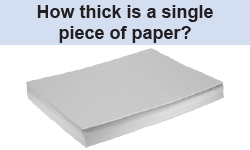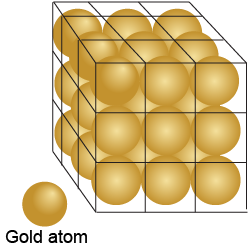| | Essential questions | | Is it possible for an answer to be “good enough”? | |
|
When an astronomer says there are 200 billion stars in the Milky Way Galaxy, how precise do you think that number is? Could it actually be 201 billion? Did an astronomer actually count every single star? One website currently lists the world population as 6,840,507,003 people. Is that number correct down to the single person? One of the most common misunderstandings about science is that science produces exact quantitative answers. Except in rare cases there are no exact answers. Even the best formulas give answers that are only good enough, and very often indirect measurements or estimation provide the best answer that there can be. 
|
Part 1: Indirect measurement
 Sometimes an object to be measured is too small or is otherwise inaccessible. Use a metric ruler, triple beam balance, meter stick, and/or protractor to make the following indirect measurements and describe your methodology:
Sometimes an object to be measured is too small or is otherwise inaccessible. Use a metric ruler, triple beam balance, meter stick, and/or protractor to make the following indirect measurements and describe your methodology: - What is the mass of a single grain of rice?
- What is the thickness of a single piece of paper?
- What is the height of a tree on the school grounds?
- In which cases is a meter stick more appropriate? A metric ruler?
- As a class, assemble your answers to parts a through c above. Use a calculator to determine the average values and the standard deviation for each. How well do your values agree?

Part 2: Atoms, size, and scale
 The density of gold is 19,300 kg/m3. The periodic table lists the mass of gold as 0.197 kg per 6.02 × 1023 atoms.
The density of gold is 19,300 kg/m3. The periodic table lists the mass of gold as 0.197 kg per 6.02 × 1023 atoms. - What is the mass of a single gold atom, in kilograms?
- Estimate how many gold atoms are in a 1 m cube.
- Assume gold atoms pack together as shown. What is the diameter (in meters) of a single gold atom?

Part 3: Estimating time
Physics deals with time scales ranging from the time it takes a single electron to move across an atom all the way up to the age of the universe. To compare times, for example, the times all must be represented in seconds. For each of the following questions, which is the larger quantity? - one year or 100,000 s
- the number of times a mosquito flaps its wings in 1 s or the number of seconds in 1 hr
- one oscillation of the quartz crystal in your watch or computer or 1 ms
- the time between your heartbeats or the time it takes a pencil to hit the ground falling from your desk

| | |
| |
|

